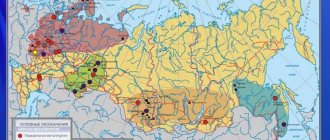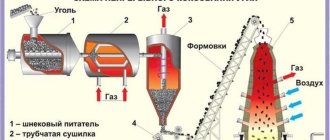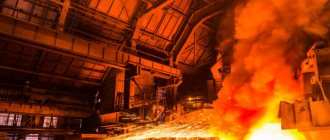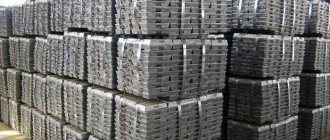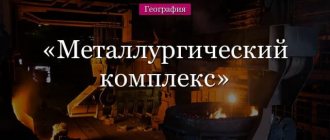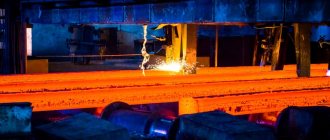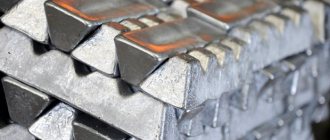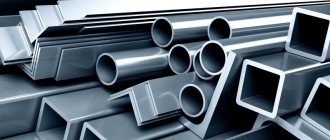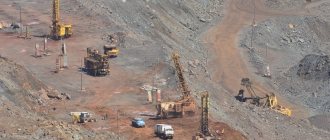Raw materials and fuel play an important role in the deployment of full-cycle ferrous metallurgy, and the role of combinations of iron ores and coking coals is especially important. A feature of the location of industries is their territorial discrepancy, since iron ore reserves are concentrated mainly in the European part, and fuel reserves are mainly in the eastern regions of Russia. Combines are created near raw materials (Ural) or fuel bases (Kuzbass), and sometimes between them (Cherepovets). When placing, the provision of water, electricity, and natural gas is also taken into account.
Three metallurgical bases have been created in Russia: Ural, Central and Siberian.
The Ural metallurgical base uses its own iron ore (mainly from the Kachkanar deposits), as well as imported ore from the Kursk magnetic anomaly and, partly, ore from the Kustanai deposits in Kazakhstan. Coal is brought from the Kuznetsk basin and Karaganda (Kazakhstan). The largest full-cycle plants are located in the cities of Magnitogorsk, Chelyabinsk, Nizhny Tagil, etc.
The central metallurgical base uses iron ores from the Kursk magnetic anomaly, the Kola Peninsula and scrap metal from Central Russia, as well as imported coking coal from the Pechora and Kuznetsk basins, and partly from Donbass (Ukraine). Large full-cycle plants are represented in the cities of Cherepovets, Lipetsk, Tula, Stary Oskol, etc.
The Siberian metallurgical base uses iron ores from Gornaya Shoria, Abakan, Angaro-Ilim deposits and coking coal from Kuzbass. Full-cycle plants are represented by the Kuznetsk Metallurgical Plant and the West Siberian Metallurgical Plant, located in the city of Novokuznetsk.
The leading place in copper smelting in Russia is occupied by the Ural economic region, on the territory of which the Krasnouralsk, Kirovograd, Sredneuralsk, and Mednogorsk plants are distinguished.
The lead-zinc industry as a whole gravitates towards areas where polymetallic ores are distributed. Such deposits include Sadonskoye (Northern Caucasus), Salairskoye (Western Siberia), Nerchenskoye (Eastern Siberia) and Dalnegorskoye (Far East). The centers of the Nickel-Cobalt industry are the cities: Norilsk (Eastern Siberia), Nickel and Monchegorsk (Northern economic region).
The production of light metals requires a large amount of energy. Therefore, the concentration of enterprises smelting light metals near sources of cheap energy is the most important principle for their location.
Ferrous metallurgy
An industry with its own nuances.
It is important to understand that not only metal is important for it, but also mining and subsequent processing. Its important features are highlighted:
- more than half of the products serve as the basis for the country’s entire mechanical engineering industry;
- a quarter of the products are used in the creation of structures with increased load capacity.
Ferrous metallurgy is production, coking of coal, secondary alloys, production of refractories and much more. Enterprises included in the ferrous metallurgy are of the greatest importance and, in fact, are the basis of the industry of the entire state as a whole.
Non-ferrous metallurgy
The second branch of the metallurgical complex is non-ferrous metallurgy. Non-ferrous metallurgy in Russia is developing using its own raw materials, because Russia is one of the largest countries in terms of reserves of non-ferrous metal ores. Its territory contains 3% of copper reserves, 40% of palladium reserves, 20% of nickel reserves and 20% of platinum reserves. Non-ferrous metal ores have several differences from ferrous metal ores. Firstly, there are much more non-ferrous ores than black ores. If black ores are iron, manganese and chromite, then there are more than 70 types of non-ferrous ores.
Read also: Gas water heater, instantaneous or storage, which is better?
Rice. 4. Groups of non-ferrous metals
Secondly, all ores of non-ferrous metals are complex, that is, one ore contains several chemical elements. For example, in the ore of the Norilsk deposit, in addition to copper and nickel, there is also silver, platinum and other chemical elements. The next feature is that non-ferrous metal ores have a very low ore content in the rock. If iron ores contain from 25% to 45% metal, then they are considered rich. Non-ferrous ores are considered rich if the metal content in the rock is from 1% to 5% for copper ores, and even less than 1% for other ores.
Ferrous metallurgy centers in Russia
First of all, it should be remembered that Russia has always been and today is the absolute leader in terms of ferrous metal production density. And this primacy is without the right to transfer to other states. Our country confidently holds its position here.
The leading factories are, in fact, metallurgical and energy chemical plants. Let's name the most important centers of ferrous metallurgy in Russia:
- Urals with iron and ore mining;
- Kuzbass with coal mining;
- Novokuznetsk;
- Location of KMA;
- Cherepovets.
The metallurgical map of the country is structurally divided into three main groups. They are studied at school and are the basic knowledge of a modern cultured person. This:
Geography of ferrous metallurgy
The oldest and most important ferrous metal production region is the Urals . 40% of steel and rolled products produced in our country are produced here. But the deposits of the Urals are already greatly depleted, so scientists believe that in 10-20 years the enterprises of the Urals will work on imported raw materials. The largest enterprises in the Urals are located in Nizhny Tagil, Magnitogorsk, Novotroitsk, and Chelyabinsk.
The second most important area is the European Center . 2/3 of the ore reserves are located here. The ore is of very high quality. In addition, there is a consumer here, but there is practically no coal. Coal is imported here from the Kuznetsk and Pechora basins. Large metallurgical centers are the cities of Tula, Lipetsk, Stary Oskol.
Rice. 2. European Center
The European North provides 20% of the country's steel and rolled products. It has its own reserves of iron ore, and coal comes from the Pechora basin. The largest metal production center here is the city of Cherepovets.
Siberia produces 16% of rolled metal and steel in Russia. The largest deposits of coking coal in the Kuznetsk coal basin and its own iron ore deposits in the Angara region and Gornaya Shoria are located here.
Rice. 3. The largest deposits of coking coal in Kuzbass
Based on Kuzbass coal and its own iron ore, a large metallurgical plant was formed here in Novokuznetsk.
Ural metallurgical base
It is this that is the main and, perhaps, the most powerful in terms of European and world indicators. It is characterized by a high concentration of production.
The city of Magnitogorsk is of paramount importance in its history. There is a famous metallurgical plant there. This is the oldest and hottest “heart” of ferrous metallurgy.
It produces:
- 53% of all cast iron;
- 57% of all steel;
- 53% of ferrous metals of all indicators that were produced in the former USSR.
Such production facilities are located near raw materials (Ural, Norilsk) and energy (Kuzbass, Eastern Siberia). Now the Ural metallurgy is in the process of modernization and further development.
Siberian metallurgical base
Perhaps it has one peculiarity: it is the “youngest” of the existing bases today. Its formation began during the USSR period. Approximately one fifth of the total volume of raw materials for cast iron is produced in Siberia.
The Siberian base is a plant in Kuznetsk and a plant in Novokuznetsk. It is Novokuznetsk that is considered the capital of Siberian metallurgy and a leader in production quality.
Development of metallurgy in Russia
Development is characterized by high rates and volumes. Therefore, huge Russia is in the lead and is constantly increasing its exports. Our country produces: 6% iron, 12% aluminum, 22% nickel and 28% titanium. this information in more detail in the production tables presented below.
Map of metallurgy in Russia
For convenience and clarity, special maps and atlases have been produced. They can be viewed and ordered on the Internet. They are very colorful and comfortable. The main centers with all divisions are indicated in detail there: copper smelters, places for the extraction of ore and non-ferrous metals, and much more.
Below are maps of ferrous and non-ferrous metallurgy in Russia.
Location of Russian ferrous metallurgy
in economic geography and regional economics, first year student gr. 13.13 Romanenko O.V.Nizhny Novgorod State University named after. N.I. Lobachevsky
Faculty of Finance, Department of Commerce.
Nizhny Novgorod
1998
Plan
The role of the metallurgical complex in the Russian economy.
Fuel and raw materials base of ferrous metallurgy.
Types of metallurgical enterprises and factors for the location of certain types of production.
Characteristics of the main metallurgical bases.
Formation of inter-district connections for ferrous metals.
Environmental problems in areas of iron and steel industry.
Problems of locating the metallurgical complex.
The metallurgical complex includes ferrous and non-ferrous metallurgy: a set of interconnected industries and stages of the production process from the extraction of raw materials to the production of finished products - ferrous and non-ferrous metals and their alloys. The integrity of this inter-industry complex is due primarily to the similarity of the industries that form it in terms of the nature of mining and the technology of pyrometallurgical processing of ore raw materials, as well as the use of finished products as structural materials. The metallurgical complex is characterized by the concentration and combination of production. The state and development of the metallurgical industry ultimately determine the level of scientific and technological progress in all sectors of the national economy. The specific features of the metallurgical complex are the production scale, which is incomparable with other industries, and the complexity of the technological cycle. The complex-forming and area-forming significance of the metallurgical complex in the territorial structure of the Russian national economy is exceptionally great.
Ferrous metallurgy is one of the most important basic branches of heavy industry. Its products serve as the basis for the development of mechanical engineering and metalworking, construction, and are also widely used in many other sectors of the national economy. The ferrous metals production system covers the entire process from the extraction and preparation of raw materials, fuel, and auxiliary materials to the production of rolled products with further processed products. It includes: mining, enrichment and agglomeration of iron, manganese and chromite ores; production of cast iron, blast furnace ferroalloys, steel and rolled products; production of electroferroalloys; secondary processing of ferrous metals; coal coking; production of refractories; extraction of auxiliary materials (fluxing limestone, magnesite, etc.); production of metallurgical products for industrial purposes. Thus, the metallurgical cycle itself (cast iron - steel - rolled products) is provided by a number of related and auxiliary industries necessary for the normal functioning of the entire process of obtaining ferrous metals.
The Russian ferrous metallurgy is distinguished by its massive scale and high concentration of production, the enormous scale of use of raw materials, fuel and auxiliary materials, the close interaction of all parts of the metallurgical process and its related industries, and the widespread disposal of industrial waste. These technical and economic features have a strong influence on the territorial organization of ferrous metallurgy: the development of raw material and fuel bases of appropriate size, the selection of the most efficient in terms of the use of natural, labor and material resources, options for locating enterprises, the establishment of certain spatial combinations of metallurgical production with other industries industry. The USSR is well supplied with raw materials for the development of ferrous metallurgy: about half of the explored ores are located on its territory. Most of them are rich (not requiring beneficiation) and relatively easy to process ores. Russia ranks first in the world in iron ore production and the level of concentration of its production.
The dynamics of the development of ferrous metallurgy can be traced from the table:
Extraction of metallurgical raw materials and production of ferrous metals in the USSR. (million tons)
The main direction of development of ferrous metallurgy in the future is improving quality and increasing the output of more efficient types of products. This will be achieved thanks to:
rapid growth of the raw material base, increasing the content of iron, manganese and chromium in concentrates, mastering the technology for enriching oxidized iron quartzites; changing the proportions between steelmaking methods in favor of oxygen-converter and electric furnace melting processes with an absolute reduction in the open-hearth method;
improving the structure of rolling production through accelerated growth in the production of cold-rolled sheets, rolled products with hardening heat treatment, shaped and high-precision rolled profiles, economical and special types of steel pipes, including multilayer pipes for gas pipelines;
the use of advanced technologies, especially in connection with the direct reduction of iron from ores, the development of powder metallurgy, special remelting and after-furnace processing of steel, continuous casting of steel;
more complete use of scrap ferrous metals and metal-containing waste.
The output of finished steel will increase without an increase in cast iron production. It is planned to improve the structure of metal products by producing rolled sheets, rolled products from low-alloy steel and with hardening treatment. It is planned to expand the production of pipes for oil and gas pipelines.
Ferrous metallurgy has the following features of its raw material base:
the raw material is characterized by a relatively high content of useful components - from 17% in siderine to 53-55% in magnetite iron ores. High-grade ores account for almost a fifth of industrial reserves used for beneficiation;
diversity of raw materials in terms of species (magnetite, sulfide, oxidized, etc.), which makes it possible to use a variety of technologies and obtain metal with a wide variety of properties;
various mining conditions (both mine and open pit, which account for up to 80% of all raw materials mined in ferrous metallurgy);
the use of ores of complex composition (phosphorus, vanadium, titanomagnetite, chromium, etc.). Moreover, more than 3/5 are magnetite, which facilitates the possibility of enrichment.
There have been structural changes in steel production. Currently, the main method of steel smelting is open-hearth. The share of oxygen-converter and electric steelmaking methods accounts for only about 1/2 of the total production volume.
Changes in ferrous metallurgy are due to the growth in the production of metal powders, the use of which makes it possible to improve the quality characteristics of products and reduce their labor and metal intensity.
It is extremely important to develop on an industrial scale the technology for producing iron from ores using the direct reduction method, which is also significantly less energy-intensive than blast furnace production. On the territory of the Kursk Magnetic Anomaly (KMA), the Oskol Electrometallurgical Plant is currently operating, with a design capacity of 5 million tons of metallized pellets and 2.7 million tons of rolled products per year.
Ferrous metallurgy is characterized by highly developed production combinations. Particularly great benefits come from combining metallurgical processing with coal coking. Therefore, the predominant part of all coke is produced by metallurgical plants. Modern large enterprises of ferrous metallurgy, by the nature of internal technological connections, are metallurgical and energy chemical plants.
Combines are the main type of iron and steel enterprises in most industrialized countries. Full-cycle enterprises produce over 9/10 of cast iron, about 9/10 of steel and rolled products. In addition, there are factories producing cast iron and steel, steel and rolled products (including pipe and hardware plants), as well as separately cast iron, steel and rolled products. Enterprises without iron smelting are classified as so-called pigment metallurgy. A special group in terms of technical and economic parameters consists of enterprises with electrothermal production of steel and ferroalloys. There is “small metallurgy” - the production of steel and rolled products at machine-building plants.
Ferrous metallurgy with a full technological cycle is an important regional-forming factor. In addition to numerous industries arising from the recycling of various types of waste during iron smelting and coal coking - heavy organic synthesis (benzene, anthracene, naphthalene, ammonia and their derivatives), the production of building materials (cement, block products), Thomas flour (for the redistribution of iron ores with a high phosphorus content), ferrous metallurgy attracts related industries. Its most typical satellites are: thermal power engineering, primarily installations that are part of metallurgical plants and can operate on by-product fuel (excess blast furnace gas, coke, coke breeze); metal-intensive mechanical engineering (metallurgical and mining equipment, heavy machine tools). Ferrous metallurgy forms around itself such powerful and diversified industrial complexes that arose in the Urals and Kuzbass.
Full-cycle metallurgy, processing and “small” metallurgy differ from each other in terms of placement. For the placement of the first, raw materials and fuel are of particular importance; they account for 85-90% of all costs for iron smelting, including approximately 50% for coke and 35-40% for iron ore. For 1 ton of cast iron, 1.2-1.5 tons of coal are required (taking into account losses during enrichment and coking), 1.5 tons of iron ore, over 0.5 tons of fluxing limestone and up to 30 m3 of recycled water. This emphasizes the importance of the mutual transport and geographical position of raw materials and fuel bases, water supply sources and auxiliary materials.
Balance reserves of iron ore amount to 107.1 billion tons, including explored reserves - 63.7 billion tons, or over 2/5 of the world's resources (1975). Of these, approximately 15% are rich ores (with an iron content of over 55%), used without beneficiation. More than 1/2 of the total proven reserves are concentrated within the KMA (16.7 billion tons) and the Krivoy Rog basin (15.5 billion tons). The Kachkanar group of deposits (6.1 billion tons) in the Urals also stands out.
The most important deposits of manganese ores are located in Western Siberia (Usinskoye).
A positive factor regarding the efficiency of enterprise location is the territorial combinations of coking coal and iron ore: Donbass - KMA, South Yakutsk basin - Aldan basin, etc. The relative location of iron ore and coking coal resources, their quantity, quality, operating conditions, proximity to industrial centers and transport routes determine the importance of each raw material and fuel base of metallurgical production in the territorial division of labor. The European part is far ahead of the eastern regions in terms of explored reserves of iron ore, and is noticeably inferior to them in terms of explored reserves of coking coal. In the eastern regions, on the contrary, there are significantly more fuel resources compared to raw materials.
For the extraction of iron ore and coking coal, the ratios between the European and eastern regions are different. The first produces more than 5 times more raw materials and 1.5 times more fuel than the eastern regions. At the same time, about 1/2 of coking coal is in the Donbass. This coal (in its natural form and as coke) is supplied to many areas of the European part and is also exported. The main source of fuel is Kuzbass (about 1/3 of the total coking coal production).
A characteristic trend in the development of ferrous metallurgy is the concentration of the extraction of metallurgical raw materials on the largest and most favorable deposits in terms of operating conditions, with the widespread deployment of the open-pit method with the subsequent beneficiation of iron ores, as well as the production of metallized pellets. In the future, the main raw material bases for ferrous metallurgy will be the KMA in the European zone, and the Angaro-Ilim and Aldan basins in the eastern regions.
Currently, the ratio of costs for raw materials and fuel shows that enterprises located near sources of iron ore and using imported fuel, all other things being equal, are able to produce cheaper metal compared to those enterprises located near sources of coking coal and using imported raw materials . However, in practice, the location of metallurgical production equally depends on both raw materials and fuel and energy factors, which is confirmed by the experience of our country. In the USSR, ferrous metallurgy, being the basis for the formation of many industrial complexes, attracts various fuel-intensive industries (chemistry, electric power, construction materials industry, etc.). Therefore, along with the areas of iron ore distribution, it also finds favorable conditions within the coal regions.
Full cycle ferrous metallurgy, depending on economic feasibility, gravitates towards sources of raw materials (Ural, central regions of the European part), fuel bases (Donbass, Kuzbass).
In some cases, it is advisable to territorially subdivide the consumed metallurgical cycle by locating the production of cast iron and steel near sources of raw materials, and the production of rolled products with products of the fourth stage (bent profiles, sheet steel with various coatings, strips, etc.) - in areas of concentrated consumption of finished products. Particle metallurgy focuses mainly on sources of secondary raw materials (waste from metallurgical production, waste from rolled products, depreciation scrap) and on places of consumption of finished products, since the largest amount of metal scrap accumulates in areas of developed mechanical engineering. “Small” metallurgy interacts even more closely with mechanical engineering.
The production of ferroalloys and electric steels is distinguished by special features of the location. Ferroalloys - alloys of iron with alloying metals (manganese, chromium, tungsten, silicon, etc.) - are produced in blast furnaces and by the electrothermal method. In the first case - at full-cycle metallurgical enterprises, as well as with two (cast iron - steel) or one (cast iron) processing stages, in the second - at specialized plants. Electrothermal production of ferroalloys, due to high electricity costs (up to 9 thousand kWh per 1 ton of product), is optimal in areas where cheap energy is combined with alloying metal resources. The production of electric steel is developed near energy sources and scrap metal.
Historically, domestic ferrous metallurgy first emerged in the central regions of the European part of the country. Starting from the 18th century, the production of ferrous metals moved to the Urals, which for a long time was the main metallurgical region.
Of the total amount of cast iron smelted in the country, over 9/10 is pig iron, the rest is foundry cast iron, and also, in small quantities, blast furnace ferroalloys. Pig iron production is concentrated in the RSFSR (over 1/2 of all smelting), where it is localized in the Urals, in the Central, Central Black Earth and Northern regions, in Western Siberia.
The current distribution of ferrous metallurgy enterprises shows that, with significant territorial concentration of production, most regions of the country use metal smelted in the Urals.
There are three metallurgical bases on the territory of Russia - Central, Ural, Siberian. These metallurgical bases vary in scale; specialization and structure of production; transport and geographical location, provision of raw materials and fuel and energy resources, the nature of the location of enterprises, the level of development of concentration and combination, technical and economic indicators of metal smelting and other characteristics.
The Ural metallurgical base is the largest in Russia and is second in terms of ferrous metal production volumes only to the Southern metallurgical base of Ukraine within the CIS. The share of Ural metallurgy accounts for 52% of cast iron, 56% of steel and more than 52% of rolled ferrous metals of the volumes produced on the scale of the former USSR. The Urals use imported Kuznetsk coal. Our own iron ore base is depleted, so a significant part of the raw materials is imported from Kazakhstan (Sokolovsko-Sarbaiskoye deposit), from the Kursk magnetic anomaly and Karelia. Strengthening the raw material base is associated with the development of titanomagnetites (Kachkanarskoye deposit) and siderites (Bakalskoye deposit), which account for 3/4 of iron ore reserves. The first ones are already involved in development (Kachkanarsky GOK). The largest centers of ferrous metallurgy were formed in the Urals (Magnitogorsk, Chelyabinsk, Nizhny Tagil, Novotroitsk, Yekaterinburg, Serov, Zlatoust, etc.). With the significant development of pigment metallurgy, the main role is played by enterprises with a full cycle. They are located mainly along the eastern slopes of the Ural Mountains. On the western slopes, pigment metallurgy is more represented.
The concentration of production in the Urals is high. The predominant part of ferrous metals is produced by giant enterprises (Magnitogorsk, Chelyabinsk, Nizhny Tagil), which arose during the years of industrialization as part of the Ural-Kuznetsk Combine (UKK). At the same time, many small factories (albeit reconstructed) have survived in the Urals, producing more than 1/10 of cast iron and steel, and more than 1/5 of all rolled products. A prominent place is occupied by the production of ferroalloys by blast furnace (Chusovoy) and electrothermal (Serov, Chelyabinsk) methods, and pipe rolling (Pervouralsk, Chelyabinsk). In addition, the Urals are the only region where naturally alloyed metals are smelted (Novotroitsk).
The ferrous metallurgy of the Urals is currently being partially reconstructed (the first stage of steelmaking at the Magnitogorsk Combine and small-capacity metallurgical plants).
The Central Metallurgical Base is an area of early development of ferrous metallurgy, where the largest reserves of iron ore are concentrated. The center, being an old region of ferrous metallurgy, developed relatively recently in two unrelated directions: the first - the smelting of foundry cast iron and blast furnace ferroalloys (Tula, Lipetsk), the second - the production of steel and rolled products mainly from metal scrap (Moscow, Elektrostal, Nizhny Novgorod, etc.).
The ferrous metallurgy of the Center is completely dependent on imported fuel (Donetsk coal or coke). The raw material resources represented by the KMA deposits practically do not limit production. Scrap metal is of great importance. Almost all iron ore is mined by open pit mining. Along with rich ores, ferruginous quartzites are mined in large quantities (Lebedinsky, Mikhailovsky and Stoilensky GOKs). The Yakovlevskoe rich ore deposit is being developed. KMA serves as a source of raw materials not only for the factories of the Center, it also provides it to a number of enterprises in the Urals, the South, and also the North. Within the KMA, a particularly promising production of metallized pellets has emerged. On this basis, electrometallurgy is developing without blast furnace processing (Oskol plant). The production of cold-rolled strip was created (Oryol Steel Rolling Plant).
The metallurgical base of Siberia as a metallurgical base of Russia is in the process of formation. Siberia and the Far East account for approximately a fifth of the cast iron and finished products produced in Russia and 15% of steel. Modern production is represented by two powerful enterprises with a full cycle - the Kuznetsk Metallurgical Plant and the West Siberian Plant (Novokuznetsk), and several processing plants (Novosibirsk, Guryevsk, Krasnoyarsk, Petrovsk-Zabaikalsky, Komsomolsk-on-Amur), as well as a ferroalloy plant (Novokuznetsk ). The raw material base is the iron ores of Gornaya Gioria, Khakassia and the Angara-Ilim basin (Kormunovsky GOK). Fuel base - Kuzbass.
The ferrous metallurgy of Siberia and the Far East has not yet completed its formation. Therefore, based on efficient raw material and fuel resources, in the future it is possible that new centers of ferrous metallurgy will emerge, in particular the Taishet plant for Kuznetsk coal and Angara-Ilim ores, as well as the Barnaul plant for the processing of Lisakovo brown iron ore to produce phosphorus-rich slag, which is important for meeting the needs Siberia in mineral fertilizers.
In the Far East, prospects for the development of ferrous metallurgy are associated with the creation of a full-cycle enterprise using coking coals from the South Yakutsk basin.
Production of ferrous metals by groups of regions of Russia.
| Udel. Weight | Steel | Udel. weight | Ready rolled products | Udel. Weight | ||
| Center | 14,0 | 29,0 | 20,7 | 28,5 | 14,6 | 29,2 |
| Ural | 25,2 | 52,0 | 40,9 | 56,3 | 26,2 | 52,4 |
| Siberia | 9,1 | 19,0 | 11,0 | 15,2 | 9,2 | 18,4 |
| Total for Russia | 48,3 | 100 | 72,6 | 100 | 50 | 100 |
Interregional connections in ferrous metals are largely due to:
the variety of rolled steel profiles produced and regional differences in the structure of their consumption;
high territorial concentration of rolled steel production;
territorial dispersion of rolled metal consumption;
inconsistency on the scale of various processing stages (cast iron, steel, rolled products) across metallurgical bases;
lack of pipe rolling in the eastern regions.
In general, it is significant that the country’s metallurgical bases exchange various rolled products with each other, moreover, they partially import them from metal-consuming areas. At the same time, the most important metal-consuming areas, where the volume of consumption far exceeds the scale of production, export certain rolled profiles.
The most important long-term task is to establish the necessary proportions between the stages of metal processing for each metallurgical base. The existing territorial differences from the point of view of combining production are such that in terms of smelting iron and steel at full-cycle enterprises, the Urals are far superior to other regions producing ferrous metals.
At the current stage of development of the national economy, the environmental situation in many regions of Russia has sharply worsened, which cannot but be taken into account in the process of locating metallurgical enterprises. The metallurgical complex has a great influence on the environment. Metallurgical enterprises are major polluters of the atmosphere, water bodies, forests, and lands. The higher the level of environmental pollution, the higher the costs of preventing pollution. An increase in these costs can lead to unprofitability of any production.
Ferrous metallurgy enterprises account for 20-25% of dust emissions, 25-30% of carbon monoxide, and more than half of sulfur oxides of their total volume in the country. These emissions contain hydrogen sulfide, fluorides, hydrocarbons, compounds of manganese, vanadium, chromium, etc. Ferrous metallurgy enterprises take up to 20% of the water of its total industrial consumption and heavily pollute surface waters.
The problems of locating this industry are particularly complex due to the fact that the high level of development of productive forces and the latest achievements of science and technology make it economically feasible to build large enterprises with multifaceted logistics connections (mines, lime quarries, coke plants, etc.). Each of these features in one way or another affects the efficiency of this industry, but the greatest importance, as a rule, belongs to the raw material and fuel factors, since ferrous metallurgy is very material-intensive.
Large-scale ferrous metallurgy can generally develop effectively only in areas that have the natural prerequisites for this. Failure to comply with this requirement leads to a shortage of prepared ores and high-quality coking coals at individual enterprises. The efficiency of location of ferrous metallurgy is also influenced by metal consumption. It was the proximity to the largest metal-consuming centers of Russia that served as one of the main factors for the creation of metallurgy in the central and northwestern regions in the 17th century and the first half of the 18th century.
The location of metallurgical plants is also influenced by the availability of water sources. In some cases, especially where the water balance is tense, their role can become decisive.
Despite the ongoing structural changes in industry caused by the chemicalization of production and the increasingly widespread use of light and non-ferrous metals, plastics and other products of chemical synthesis, ferrous metals have not lost their role as the main structural material in industry and transport. They are widely used in construction and other sectors of the national economy. Their production remains one of the most important indicators of the industrial development of a country, reflecting its technical level.
Bibliography
“Economic geography and regional economics” Compiled by: senior teacher K.A. Gulyaeva - N. Novgorod: Nizhny Novgorod State University, 1996.
"Regional Economics" ed. prof. T.G. Morozova.
“Location of Geography of Industry of the USSR”, M,: 1990.
"Economic Geography of the USSR" ed. A.D. Danilova, V.V. Kistanova, S.I. Ledovskikh, M.: 1983.
N.D. Lelyukhina “Economic efficiency of location of ferrous metallurgy”, M.: 1973.
